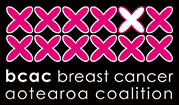The Breast Cancer Aotearoa Coalition (BCAC) wants to see a breakthrough new radiation technology used more widely to treat thousands of New Zealand women with breast cancer.
Intra-Operative Radiation Therapy (also known as IORT) is used in women with low-risk early-stage breast cancer and means they receive a single shot of radiation during surgery to remove the tumour.
The treatment can save women from having weeks of follow-up radiation treatment, but is currently only being used in a private hospital setting.
BCAC chairperson, Libby Burgess, says the charity would like to see women in the public system receiving the treatment.
“We don’t believe that New Zealanders should miss out on world-class treatments such as this. This is a revolutionary new technology that will allow women with early breast cancer to be treated effectively, safely, quickly and cheaply.
“It will save many women the stress and anxiety of traveling for weeks of traditional radiation treatment and it could potentially mean that more women will chose breast conserving surgery over a more invasive mastectomy,” Ms Burgess says.
BCAC believes up to 1,000 women a year could benefit from the new treatment. Ms Burgess says the benefits of Intraoperative Radiation Therapy for women are numerous and include:
- a reduction in radiation treatment time
- no requirement for those who live rurally or in smaller centres to travel to a city for daily radiation treatment for up to five weeks
- less stress on women because they don’t require further treatment and can get back to their families and workplaces faster
- fewer radiation burns to the skin
- less radiation damage to the lungs or heart
- a potential reduction in the rate of mastectomies.
Ms Burgess says the new technology is low risk and a large clinical trial (TARGIT) has shown that women who receive radiation intra-operatively at the time of surgery to remove the breast cancer tumour have low rates of disease recurrence and similar breast cancer survival rates to those receiving traditional radiation treatment.
In addition, she says the health system will benefit from the new technology because it is cheaper to provide than the five weeks of traditional radiation treatment.
“It seems like a no-brainer to us. It’s better for the patients being treated and it’s far cheaper to provide compared with weeks of traditional radiation therapy,” she says.
BCAC is asking everyone with an interest in improved cancer treatments for women with breast cancer to write to the Minister of Health, Dr Jonathan Coleman, asking him to ensure that Intra-Operative Radiation Therapy is made widely available in the public health system.
ENDS
2 June 2016
About Intra-Operative Radiation Treatment (IORT):
- The treatment is suitable for women with low-risk early-stage breast cancer and should only be used on those who meet the eligibility criteria.
- It involves a single dose of radiation being delivered internally at the time of surgery to remove the tumour.
- It could save women who have a lumpectomy or a partial mastectomy from having up to five weeks of daily radiation treatment.
- BCAC estimates that around 1,000 New Zealand women every year could benefit from the treatment.
- A large clinical trial (TARGIT) has found that long-term survival rates for women treated with intra-operative radiation at the time of surgery to remove the breast cancer tumour were similar to those who received traditional radiation treatment (The Lancet, Volume 383, 603 - 613)
- The TARGIT study found that women who received IORT were much less likely to experience skin complications than those who received traditional treatment.
- The treatment is publicly funded in Australia and is available in over 300 centres in 14 countries around the world.
For more information see BCAC's 2013 submission to the National Health Committee.



